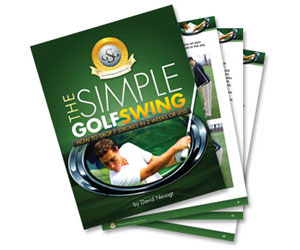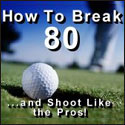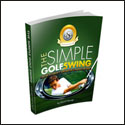Golf Tips For Hitting A Great Shot Nearly Every Time
If you hit a great shot every time, you would be world champion!
But if you follow these tips you will hit a great shot nearly every time and at least make a major improvement in your game:
Once the swing gets down to the so called hitting area correctly, the chance of its going wrong is very slight.
Yet, golf being the strange game that it is, there is still the possibility of the good swing going off the track at this late stage.
In both the good swing and the bad, though, when the flaws appear they appear for basically the same reason-trying to “help” the club head get to the ball.
They will appear in the good swing when the player loosens his left-hand grip slightly and collapses his left elbow.
As the result of these actions there comes a peculiar body movement, a sort of heaving action, as though the player were trying, with the body, to help the swing or help hit the ball. It is a very strange contortion indeed.
In this movement the loosening left-hand grip and the collapsing left elbow have the effect of bringing the club up sharply instead of letting it go down and through the ball as it should. The left elbow crooks and bends out to the left, toward the target.
This suddenly shortens the radius of the swing, and since the straight left arm has been performing the function of a constant radius all through the swing, there is nothing for the club to do but come up.
If the swing happens to be from the inside, the loosening left hand and automatic strengthening of the right hand will cause the ball to be hit out to the right a push.
It may be a topped push or, if the club isn’t brought up far enough to make it top the ball, just a push. There is usually trouble to the right on any shot, as every slicer knows, and it doesn’t make any difference whether we slice the ball into that trouble or hit a straight ball into it. It still costs strokes.
A third possibility these flaws may lead to, if they are slight rather than pronounced, is a straight ball that doesn’t go anywhere a dead ball. This, of course, is caused by the loosening of the left-hand grip. The strong connection between the motive force of the arm and the club that is being motivated is weakened. The connecting link (the hand) gives slightly at impact and force is lost.
The best strokes for the good player, of course, are simply to keep his grip tight, hold the wrist position gained by the backward break, hit through with his hands, and let CQAM Jake its course. The first insures a strong, live connecting link between the arms and the club at impact. The second insures a square club face. The hard-swinging hands provide the speed. But COAM? What is COAM anyway?
COAM is the Conservation of Angular Momentum. In the golf swing it is the mysterious factor that makes the club head catch up to the hands, without any effort on the part of the player. Just a few more paragraphs and we will give you the full explanation.
For the poor or average player the same magic moves apply, but he must first learn to get himself into the position the good player is in as he reachers the hitting area retains the hand and wrist position, slides his hips laterally to the left, permits no hand lag, and makes no effort to move the club.
If he does these things he will keep unchanged the eternal triangle and he will be letting the body move the club. If he doesn’t do these things he will never be in the right hitting position. There are just no two ways about it.
The good player is moving most of his weight toward his left leg and his right heel has come up off the ground slightly. His body is beginning to bow out to the left, led by the hips. The upper part of his body, anchored by his head is still back, and his shoulders have not yet turned past the ball, though the left shoulder has risen and the
right shoulder has dropped.
His right arm is in close to his body. His hands are near his right leg but the club is still about horizontal and much of the wrist cock has been retained.
The good player here is coming down into a position behind the ball, so that he can hit it “out from under” and from the inside. He is not turning high and over the ball.
The most puzzling part of this picture is the position of the club, or of the hands and the club. The hands are so far down but the club still has so far to go, a full quarter-circle.
Pictures similar to this one have been printed by the thousands since the advent of high-speed photography. They are perfect for showing us how we should be at this late stage of the swing. But we believe also that they have caused more bad shots than any others ever printed.
Why? Because they have implanted&’and if not implanted, strengthened&’a terrible fear in the mind of the golfer. This is the fear that if he ever gets in this position he will never be able to make the club head catch up to his hands at the ball. Therefore, from this position he feels he would hit worse shots than he hits now, if indeed he were able to hit the ball at all. It looks, to him, impossible.
This is one of the fears that we dwelt on lightly in the preceding chapter&’the fear that you will not be able to make the club head move fast enough. It is largely accountable for what we have termed the average golfer’s eternal preoccupation with the club head.
He thinks of it as the tool that hits the ball, of course, and right from the top of the swing he starts to manipulate it to make it go faster. Or he retards his hands so the club head will catch up. Even though he knows he should not do these things, his subconscious takes command over his reason (as it always will), and he gets an action which has long been known as “hitting too soon,” or “hitting from the top,” or just plain “flipping.” The deep urge to do this is motivated not alone by the idea that he must make the club head catch up to his hands.
Part of it stems from the mistaken idea that he must snap his wrists into the shot. We are not saying this snapping cannot be or isn’t done by experts. We are saying that it isn’t necessary for the average player. Even worse, it is suicidal. The average player, trying to do it, always gets the club head to the ball ahead of his hands.
That is because, as we have mentioned, the swing through the ball is only a continuation of the first movement of the downswing, the movement that brings us to the hitting area.





